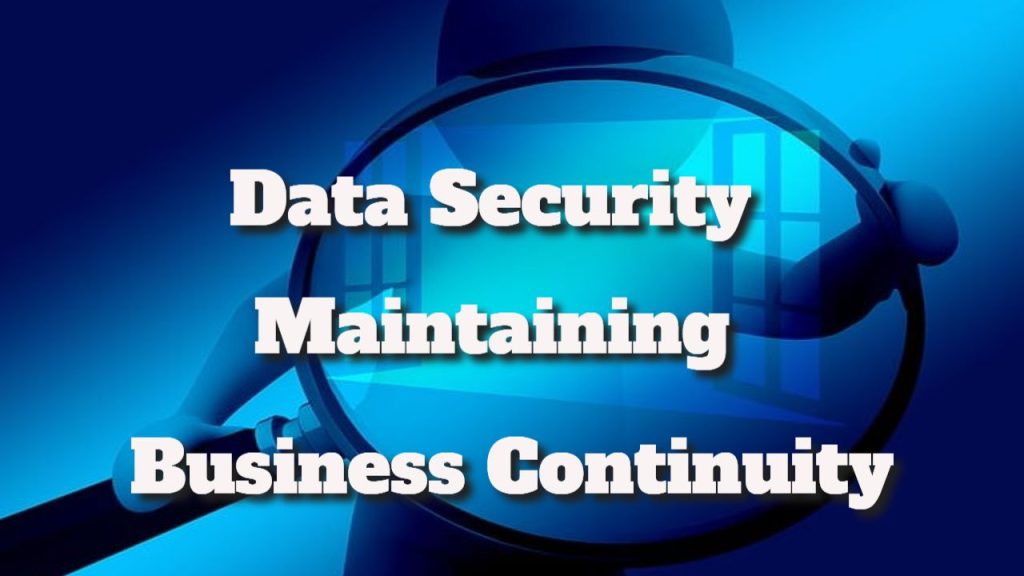Data Security Maintaining Business Continuity
Data Security Maintaining Business Continuity: With the rapid pace of information transfer and the constant presence of cyber threats, ensuring uninterrupted company operations in today’s uncertain business landscape is more crucial than ever. Organisations can’t survive or prosper in an unpredictable and unstable environment without data protection to safeguard vital information assets.
We provide a comprehensive overview of data protection and stress its importance in the current uncertain climate. Data protection, in its most basic definition, is a system of policies, procedures, and technology to safeguard confidential information from prying eyes.
Protecting against external dangers, such as hackers and cybercriminals, and internal vulnerabilities, such as staff negligence or system failures, is the essence of good cybersecurity.
Establishing suitable data protection practices may help businesses lessen the likelihood of data breaches, protect their reputation, and increase consumer trust.
Data protection is crucial in this age of ever-changing digital landscapes and ever-more-advanced attack methods.
Confidentiality is an essential feature that guarantees sensitive information is accessible only to permitted individuals or systems.
Secure data transmission and storage in the cloud is possible thanks to encryption and other access control measures that prevent unauthorised parties from accessing sensitive information.
Integrity is another pillar of data protection; its focus is the maintenance of data accuracy and consistency across time. Protecting vital information from unauthorised alterations or attempts at tampering is the job of verification systems like digital signatures or checksums.
This ensures that the company and its stakeholders can trust the data, which helps make informed decisions and avoid harmful consequences.
Data security, especially during challenging times, depends on availability. Data and information systems must be accessible and functional at all times, which is guaranteed by it.
To ensure that essential data remains accessible in the face of disruptive events like power outages, cyber-attacks, or natural catastrophes, businesses create backup and recovery procedures, set up redundant equipment, and create contingency plans. Data protection also includes overseeing the data lifecycle or handling data from its creation to its disposal.
Data is efficiently handled throughout its lifetime due to correct classification, retention policies, and secure disposal procedures.
The risk of retaining unnecessary or outdated data is reduced, legal infractions are avoided, and data management processes are streamlined due to this all-encompassing strategy, which improves company efficiency.
Rapid technological advancements provide new challenges to data protection, which calls for constant adaptation. New security risks from the Internet of Things and cloud computing have emerged alongside cutting-edge technology like artificial intelligence. If businesses want to keep their data safe from assaults and adapt to new ecosystems, they must have a firm grasp of these dynamics.
With today’s business climate so unpredictable, data security is more important than ever.
Companies may reduce vulnerability, maintain credibility, and guarantee company continuity by prioritising data privacy, availability, integrity, and lifecycle management.
In what follows, we’ll go further into the nuances of data protection and offer many strategies, recommendations, and cutting-edge tools businesses may use to keep sensitive information safe.
In the upcoming section of this chapter, we will look into the growing importance of data security in uncertainty and examine how data protection is evolving.
The data protection landscape is complex and constantly evolving. Therefore, organisations must be ready to adapt to new technologies.
The second part of this chapter delves into the critical questions about data security during times of chaos, offering helpful guidance and insights to organisations that want to keep their businesses running smoothly and protect their essential data.
Data protection relies on proactively finding and reducing vulnerabilities and threats. To adopt security solutions before an attack occurs, companies might benefit from regularly conducting vulnerability scans and risk assessments.
Businesses may lessen the blow of cyber incidents and stay ahead of possible dangers if they take preventative measures to safeguard customer data.
The human element needs to be acknowledged in data protection programmes. Education and training programmes are essential to equip employees to identify and appropriately react to potential security risks.
Information security must be a top priority, and everyone must do their part to keep sensitive data private, authentic, and easily accessible. Building a data security culture that is a top priority in an organisation can be achieved by consistent training, practice with real-world scenarios, and constant communication.
Protecting sensitive information requires increasing staff expertise and imposing stringent access controls. With the help of RBAC and the principle of least privilege, employees are only granted access to the necessary information to carry out their responsibilities.
Another helpful strategy is the division of labour when employees are entrusted with different aspects of critical processes to lessen the likelihood of unauthorised access or malicious activity. By implementing rigorous access restrictions, organisations can reduce the likelihood of insider threats and mitigate the consequences of a breach.
Having backup and recovery alternatives is essential for a robust data protection plan. Organisations can ensure quick recovery in the case of data loss or system failure by regularly backing up vital data and storing it in secure locations or using cloud-based solutions.
Protect yourself from physical harm, theft, and natural disasters with off-site backups. Maintaining reliability and minimising downtime necessitates routine testing of backup and recovery procedures.
The use of solid encryption techniques is another essential component of data security. Even if data is available, encryption transforms it into an unintelligible format that no one else can read.
Businesses can reduce the likelihood of unauthorised access or interception by encrypting data while it is at rest, in transit, and use.
Using robust encryption methods and keeping encryption keys secret is essential for protecting the privacy and integrity of sensitive information.
The Internet of Things (IoT), cloud computing, and artificial intelligence (AI) are new technologies requiring updated data security protocols. Organisations can benefit from real-time threat detection and response systems powered by artificial intelligence to identify and reduce security threats.
Increased scalability, data redundancy, and built-in security are all benefits of cloud-based solutions.
Regarding security and privacy, organisations must be careful when choosing cloud service providers.
Essential elements of a suitable data protection strategy are incident reaction and continuous monitoring. Instantaneous detection of anomalies or suspicious conduct is made possible by monitoring networks, systems, and user activity.
Businesses can assess the consequences of a possible security breach and move swiftly to contain and lessen the damage when they respond and investigate incidents quickly.
Formalising response methods, conducting regular drills, and establishing an incident response team are crucial to mitigating the effects of cyber attacks.
Ultimately, data protection is an ongoing process that calls for a complete understanding of the dynamic environment and the implementation of preventative actions.
Adapting to new technology, identifying vulnerabilities and threats, training employees, implementing strong access controls, backup and recovery mechanisms, encryption techniques, and ensuring business continuity are all components that organisations should consider.
Data protection in today’s turbulent business world is an ongoing effort to prevent risk and maintain confidence rather than a one-time occurrence.
A Robust Data Security Framework Must Be Established
In today’s dynamic and interconnected world, organisations face multiple challenges regarding safeguarding critical data. It is more important than ever to safeguard the safety and uninterrupted running of business activities in light of the proliferation of cyber dangers, natural catastrophes, and unforeseen interruptions.
To protect sensitive data during disruptions, this chapter lays out the essential elements for creating an effective data security architecture.
1. Check for Exposures and Dangers
Before implementing data security solutions, a comprehensive vulnerability and risk assessment must be carried out. Part of this process is looking for external and internal dangers to data availability, integrity, and security. It is possible to put appropriate and focused safeguards in place for an organisation after its risks have been identified.
2. Here Are the Definitions of Access Controls:
Robust access restrictions are necessary to protect data from unwanted access. As part of this process, it is essential to establish user roles and permissions, employ robust authentication methods such as multi-factor authentication, and review and update access authorizations regularly. Reduce the possibility of data breaches by limiting access to sensitive information to authorised personnel only.
3. Implementing Cryptography:
When storing or delivering data, encryption is a robust method for avoiding unauthorised access. Data becomes unreadable to unauthorised parties without the decryption key when encrypted. To keep data secure even in unpredictable settings, reliable encryption solutions and secure critical management processes are essential.
4. Ensuring the Safety of Data:
To keep data secure during times of disruption and chaos, it is essential to perform regular backups. By creating numerous copies of critical data, organisations can keep it accessible even during ransomware attacks, hardware failures, or natural disasters. Storing backup data in secure off-site facilities or cloud-based solutions improves reliability and accessibility.
5. Develop protocols for handling incidents:
Incidents can still happen no matter how robust the data security framework is. Therefore, companies need an incident response plan to limit possible damage effectively. In the event of a data breach or other security incident, this plan should include the steps to take in order to communicate, assemble a response team, and recover from the incident. Testing is key to keeping incident response processes up-to-date and effective.
6. Educational and Awareness Programmes:
Employees have a crucial role to play in keeping sensitive information safe, and data security is something that everyone is responsible for. Organisations should provide comprehensive security training and awareness programmes to teach employees about security risks, best practices, and crisis response procedures. By establishing a robust security culture, organisations can strengthen their ability to withstand unpredictable situations.
As our society increasingly relies on technology and data, the risks to data security are steadily increasing. To keep operations running smoothly during turbulent times, businesses must develop a robust data security plan.
Critical steps in building such a framework were discussed in the earlier part of this chapter, including security audits, authorization restrictions, encryption, data backups, incident response protocols, and employee education and development.
Through these measures, businesses can enhance the security of sensitive data and mitigate the risks associated with chaotic settings.
Implementing Strict Measures to Protect Data
After addressing the procedures to build a data security architecture that can withstand chaos, this chapter will cover the essential things organisations should do.
By implementing these techniques, businesses can improve their ability to protect sensitive information and maintain operations uninterrupted in the face of uncertainty.
7. Regular Checks and Evaluations:
A robust data security system must be audited and monitored continuously to identify any unauthorised activity or weaknesses.
With trustworthy monitoring tools and regular audits, businesses may find security breaches and vulnerabilities quickly and fix them.
Proactively addressing issues enables prompt repairs, reducing the likelihood of future risks and their potential impact on business operations.
To protect sensitive information from unauthorised access, storage, or transfer, data loss prevention (DLP) solutions are essential. These systems monitor and restrict data flow.
These solutions identify potential data breaches by integrating pre-existing policies, content inspection, and user behaviour monitoring and execute the necessary preventive measures.
Data loss prevention (DLP) solutions allow businesses to safeguard sensitive data and reduce the likelihood of data breaches.
9. Establish Reliable Network Boundaries:
Organisations are compelled to construct secure network perimeters to safeguard themselves in an interconnected world. Protecting sensitive information and lowering the attack surface can be achieved through firewalls, intrusion detection systems, and robust network segmentation techniques.
By limiting access to internal network resources to approved connections, organisations can lessen the chances of unauthorised access and strengthen their defences against possible threats.
10. Testing for Vulnerabilities and Penetration regularly:
Businesses should conduct penetration testing and vulnerability scans regularly to ensure their safety. Organisations can fix security holes in their systems, applications, and networks before attackers can exploit them, thanks to these tests.
Through penetration testing, which simulates actual attacks, businesses can find and fix security holes.
11. Conformity with Recognised Industry Standards and Best Practices:
Businesses should always be one step ahead of the curve when protecting sensitive customer information. Implementing a cybersecurity framework and adhering to standards like ISO 27001 and the National Institute of Standards and Technology (NIST) can guarantee the safety, integrity, and accessibility of sensitive data.
There are a lot of controls and rules in this framework. Compliance with these standards demonstrates an organization’s dedication to data security and helps establish industry-accepted security processes.
12. Ongoing Training and Education:
Adapting one’s knowledge and abilities in data security to the ever-changing landscape of potential dangers is an absolute must. By funding employees’ attendance at pertinent conferences, training, and certification opportunities, businesses may foster a culture of lifelong learning.
Well-informed staff members who have the necessary abilities will be better prepared to implement stringent security protocols and take the lead in the fight against data breaches.
By implementing these extra measures, companies can fortify their data security system and build a robust defence against interruptions caused by disorder.
Data security is not an event that happens once; instead, it is an ongoing process.
To keep data secure, it’s essential to check for updates, adjust to new threats, and monitor technology developments.
The reputation of a business, the trust of its stakeholders, and the potential reduction of legal and financial risks associated with data breaches can all be enhanced by taking a proactive approach to data security.
Maintaining business operations and achieving long-term success depends on an organization’s capacity to adequately protect and restore its digital assets during times of uncertainty.
At last, the essentials of constructing a reliable data security system have been reviewed in this chapter.
Organisations can fortify themselves against chaotic occurrences by assessing their weaknesses and risks, implementing access restrictions, encrypting data, backing up data, creating protocols for responding to incidents, and raising awareness and training.
By implementing the ideas outlined in this chapter, organisations may face the challenges of a globally interconnected world without compromising the safety and sustainability of their operations.
Data Protection for Business Continuity
Offering ongoing business continuity has become a significant challenge in today’s rapidly evolving technology ecosystem, where data is vital to organisations.
The increasing sophistication and frequency of cyber-attacks and the risk of natural disasters and other unplanned interruptions make it imperative for organisations to establish robust protocols to safeguard critical data while preserving operational efficiency.
Organisations must include data protection measures in their overall continuity planning to overcome these problems. Doing so can make their operations more resilient to shocks and keep things running smoothly.
We Look at Data Protection Strategies and Best Practices That Can Keep Your Business Running Smoothly.
Data security and continuity planning depend on reliable backup and recovery systems. Reduce the likelihood of data loss due to power outages, cyberattacks, or extreme weather by periodically storing backups in a safe location off-site or on the cloud.
Organisations should establish backup policies and procedures with clear definitions to ensure that critical data is always safe and can be quickly restored in the event of a disaster.
In addition to backups, businesses should think about data recovery procedures. As part of this process, it is essential to frequently evaluate backup systems and ensure data can be retrieved correctly.
Organisations may improve their strategies and proactively fix issues by conducting regular data recovery exercises, which reveal gaps and vulnerabilities in their data security infrastructure.
Data encryption is an essential component of data protection for ensuring business continuity. Encryption renders data unintelligible, making it extremely difficult for unauthorised parties to access or misuse.
Businesses can achieve secure data transmission and prevention of data breaches by utilising robust encryption algorithms and strictly following encryption best practices.
In addition, businesses should take the initiative to secure their data by establishing stringent authentication protocols and limiting access.
This lessens the possibility of internal data breaches by ensuring that only authorised personnel can access sensitive information.
Multi-factor authentication, role-based access controls, and frequent employee security training can significantly enhance data security and overall resilience.
Creating suitable backup and contingency plans is another critical component in guaranteeing company continuity.
Data breaches, cyberattacks, and other interruptions should be addressed in these strategies through particular policies and procedures. If these plans are to remain successful and relevant in the face of evolving threats, they must undergo frequent testing and updates.
By integrating data protection measures into their overall continuity strategy, organisations can significantly enhance their resilience to disruptions and maintain uninterrupted operations. The second part of this chapter will focus on specific technologies and solutions that might help businesses achieve strong data security and continuity of operations.
To keep operations running smoothly and prevent disruptions, it is essential to build data protection frameworks, use state-of-the-art technology, and use data backups.
As cyber threats and interruptions continue to escalate, these tools and technology are more important than ever. By following these steps, companies may safeguard their operations and avoid potential disruptions.
Businesses need advanced threat detection and defence technologies to keep data safe and operations running smoothly. These systems use AI and ML algorithms to detect and fix real-time security flaws.
These systems can detect threats before they cause significant damage by continually monitoring network traffic and analysing patterns. If businesses want to improve their cyberattack detection, prevention, and mitigation capabilities, they should consider purchasing these technologies.
With the help of intrusion detection and prevention systems (IDPS), organisations can enhance their threat detection and prevention capabilities. To prevent or terminate suspicious behaviour, these systems monitor network traffic, look for attempts at unauthorised access, and block them.
Businesses can safeguard their data and forestall security breaches by utilising IDPS. Maintaining these systems’ efficacy in the face of ever-changing cyber threats requires frequent updates.
With cutting-edge threat detection and protection technologies, businesses should implement safe cloud storage solutions. In terms of data security and company continuity, there are several benefits to storing data in the cloud.
Businesses may quickly scale up their storage space as their needs expand, all the while rest assured that their vital data is constantly and securely backed up. Because data is preserved and copied over several servers, cloud storage further lowers the threat of physical device failure or damage.
This redundancy makes The data more resilient and can be recovered quickly during a cyberattack or natural catastrophe.
For data privacy and security, businesses should use robust encryption technologies. Techniques for encrypting data render it unusable to unauthorised third parties by transforming it into an unreadable format.
Encrypting sensitive data before, during, and after transmission using a widely used technique like Advanced Encryption Standard (AES) guarantees its safety.
Databases, file systems, and communication routes should all be encrypted to protect against such weaknesses.
In addition, companies should check in on their data security and business continuity plans frequently. This includes finding possible holes in the data protection architecture by conducting penetration and vulnerability assessments.
By regularly reviewing and improving security protocols, organisations can stay ahead of cyber threats and ensure their data protection measures work.
Lastly, businesses must establish who is responsible for what to ensure data security and company continuity. The organization’s capacity to react to disruptions can be greatly enhanced by assigning someone to oversee and manage these procedures.
Through consistent training and awareness initiatives, staff members should be educated on their respective duties in maintaining data security.
By doing so, we can be sure that all of our employees are on the same page regarding the critical nature of keeping sensitive information secure and accessible at all times.
A multi-pronged approach is required to ensure data protection and, by extension, company continuity.
Organisations may strengthen their resilience to interruption and disorder by implementing advanced threat detection and protection systems, utilising secure cloud storage solutions, employing robust encryption techniques, and conducting frequent audits and monitoring.
A data security and resilience culture can be more easily established with the help of well-defined duties and regular training courses.
By implementing these measures, organisations may effectively navigate the ever-changing digital landscape without disrupting their operations.
The post Data Security Maintaining Business Continuity appeared first on Survival Avenue.
The post Data Security Maintaining Business Continuity appeared first on https://gqcentral.co.uk






Comments are closed